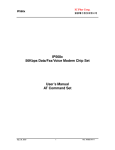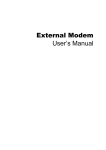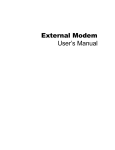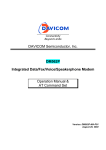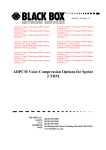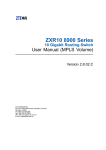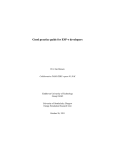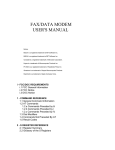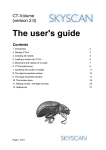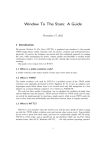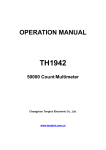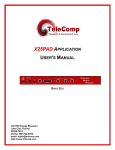Download TP560i
Transcript
TP560i
TP560i
56Kbps Data/Fax/Voice Modem Chip Set
PCI Bus Interface
User’s Manual
AT Command Set
99/10/18
1
Rev. TP560i-AT-10
TP560i
Introduction
This is a high performance ITU-V.90 56Kbps modem;
Computer can make connection with remote terminal, send a
fax and be a telephone answer machine by this modem. In
data mode, this modem provides ITU V.90, V.34, V.32bis,
V.32, V.22bis, V.22, V.23, V.21 and bell212A/103 connection
protocol speed from 300bps to 56Kbps. This modem also
provides MNP class 5 and V.42bis compression method
during data transmission. In Fax mode, this modem can
send and receive Fax in 14.4kbps that is compatible to ITUV.17 standard, Fax function is follow ITU Group 3 fax standard.
More detail information, please refer to user’ s manual of
communication software and AT command set.
Packing information
1.
2.
3.
4.
5.
3. Chose Driver source is in floppy drive A (or B).
4. Click on OK. Windows 95 automatically copies the modem
driver to your hard disk and uses it.
5. Eject the disk and store it in a safe place.
6. Your modem is now installed. Now install the fax and data
software that came with your modem, as explained in your
modem manual.
AT Commands Reference
User’ s manual
Communication Software
RJ-11 telephone cable
3.5 inch Disk (Win95/98 Driver & INF files)
Ear Phone and Mic Phone
Hardware Installation
Starting the Installation
1.
2.
Turn off your computer and unplug its power cable.
Unplug your computer before removing the top or you
could hurt yourself and damage the equipment.
3.
Remove the computer cover according to the directions
in the computer manual.
4.
Choose a PCI slot.
5.
Remove the rear panel metal bracket that corresponds
to the slot you plan to use.
6.
Hold the modem over the expansion slot. Place the
modem into the slot and push it down so that it is firmly
seated.
7.
Replace the computer cover.
8.
Plug one end of the supplied phone cable into line jack
on the modem metal bracket, the other into a modular
phone wall jack.
9.
You can connect a phone to your modem by plugging
the phone modular plug into the modem’ s phone jack.
With this arrangement you can use your telephone
normally when the modem isn’ t being used.
11.
2. Insert the Disk that is provided by hardware manufacture
into floppy drive A (or B).
Turn on the computer.
AT commands are issued to DTE to control the modem's
operation. AT commands can only be entered while the
modem is in command mode. Except for the A/ command and
the +++ escape command, all commands must be prefixed
with the attention code AT. For instance, the “ A” command
(below) would be entered as: "ATA<CR>". Without the AT
prefix, the command line cannot be executed. For example:
The format for entering AT commands is “ATXn” where X is
the AT command, and n is the specific value for that
command.
More than one command can be placed on a single line and (if
desired) separated with spaces for readability. Once the
carriage return (Enter) key is pressed, the command line is
executed. A line with no carriage return is ignored. Any
command issued is acknowledged with a response in either
text or numeric values known as result codes. In the following,
all commands, command-values and result code recognized
by the modem are shown; any entries other than those shown
cause the ERROR result code. The modem accepts either
upper or lower case characters in the command line and
ignores any spaces within or between commands. Typing
errors can be corrected with the Backspace key. Exceptions
are noted in the description of specific commands.
+++AT Escape Sequence
The escape sequence allows the modem to exit data mode
and enter online command mode. While in online command
mode, you may communicate directly to your modem using
AT commands. You may return to data mode by issuing the
ATO command.
Section 1. Data Mode Command
A/ Executes Last Command
When modem receives this command, modem executes the
last command string entered. Do not conclude it by pressing
“Enter”.
Windows 95/98 installation
A Answer Command
This command instructs the modem to go off-hook and
answer an incoming call.
If your computer uses Windows 95, plug and play?
Both
Windows 95 and your computer support plug & Play. Plug and
Play lets you plug in a device such as your modem and then
use it immediately.
To finish your Windows 95 installation, follow these steps
1. Turn on your computer if it not already on. If the New
Hardware Found dialog box appears, you need to install a
modem driver file, as explained in steps 2. If the New
Hardware Found box does NOT appear, Windows 95
already has a driver for your Modem. Skip ahead to step 6.
Bn Communication Standard Setting
This command determines ITU-T vs. Bell standard.
B0 Selects ITU-T V.22 mode when the modem is at 1200
bits/s.
B1 Selects Bell 212A when the modem is at 1200 bits/s
(default).
Result Codes:
OK : n = 0, 1
ERROR : Otherwise
99/10/18
2
Rev. TP560i-AT-10
TP560i
Dn Dial
This command instructs the modem to begin the dialing
sequence. A dial string can be up to 40 characters long. Any
digit or symbol (0-9, *, #, A, B, C, D) could be dialed as touchtone digits. The following may be used as dial string modifiers:
P
T
W
@
Pulse dialing.
Touch tone dialing (default).
Wait for second dial tone.
Wait for quiet answer. Wait for five seconds of silence
after dialing the number.
! Hook flash.
, Pause during dialing.
; Return to command mode.
^ Enable data calling tone transmission.
S = n Dial a telephone number previously stored using the
&Zn = x command (see the &Zn = x command for
further information). The range of n is 0,1,2.
En Echo Command
ATEn command controls whether or not the characters
entered from your computer keyboard are echoed back to
your monitor while the modem is in command mode.
E0 Disables echo to the computer.
E1* Enables echo to the computer (default).
Result Codes:
OK: n = 0, 1
ERROR: Otherwise
Hn Hook Control
This command instructs the modem to go on-hook to
disconnect a call, or off-hook to make the phone line busy.
H0 Modem goes on-hook (default).
H1 Modem goes off-hook.
Result Codes:
OK: n = 0, 1
ERROR: Otherwise
In Request Identification Information
This command displays specific product information about the
modem.
I0 Returns product ID code.
I1 Display Firmware version and checksum on the DTE.
I2 Customer Used.
I3 Returns fix ID information for application software
identification. “TP560 Data/Fax/Voice 56K Modem”
I4 Returns firmware version for data pump.
I5 Returns country code.
I6 Blacklist times
I9 Return Software Speakerphone or Hardware
speakerphone
I10 Checksum
Result Codes:
n = 0, 1, 2, 3, 4, 5,6,10
ERROR: Otherwise
Nn Modulation Selection
This command controls whether or not the local modem
performs a negotiated handshake at connection time with the
remote modem when the communication speed of the two
modems is different.
N0 When originating or answering, this is for handshake
only at the communication standard specified by AT*In.
N1* During handshake, Highest speed is specified by AT*In.
Depend on line quality fallback to a lower speed may
occur.
Result Codes:
OK n = 0, 1
ERROR Otherwise
On Return Online to Data Mode
O0* Exit online command mode and return to data mode (see
AT Escape Sequence, +++AT).
O1 This command issues a retrain before returning to online
data mode.
O2 This command issues a rate re-negotiation before
returning to online data mode.
Result Codes:
OK n = 0, 1, 2
ERROR Otherwise
P Select Pulse Dialing
This command configures the modem for pulse (non-touchtone) dialing.
Result Codes: OK
Qn Result Code Control
Result codes are informational messages sent from the
modem and displayed on your monitor.
Q0* Enables modem to send result codes to the DTE.
Q1 Disables modem from sending result codes.
Result Codes:
OK n = 0, 1
ERROR Otherwise
T Select Tone Dialing
This command instructs the modem to send DTMF tones
while dialing.
Result Codes: OK
Ln Monitor Speaker Volume
This command sets speaker volume to low, medium, or high.
L0 Select low volume.
L1 Select low volume.
L2* Select medium volume.
L3 Select high volume.
Result Codes:
OK n = 0, 1, 2, 3
ERROR Otherwise
99/10/18
Mn Monitor Speaker Mode
This command turns the speaker on or off.
M0 The speaker is off.
M1* The speaker is on until the modem detects the carrier
signal.
M2 The speaker is always on when modem is off-hook.
M3 The speaker is on until the carrier is detected, except
while dialing.
Result Codes:
OK n = 0, 1, 2, 3
ERROR Otherwise
3
Vn DCE Response Format
This command controls whether result codes are displayed as
words or their numeric equivalents.
V0 Displays result codes as numeric.
V1* Displays result codes as text.
Result Codes:
OK n = 0, 1
ERROR Otherwise
Rev. TP560i-AT-10
TP560i
Wn Result Code Option
Zn Recall Stored Profile
This command instructs the modem chip set to go on-hook
and restore the profile saved by the last &W command.
Z0 Reset modem and retrieve active configuration profit
from stored profit 0.
Z1 Reset modem and retrieve active configuration profit
from stored profit 1.
Result Codes:
OK n = 0, 1
ERROR Otherwise
W0 Display “ CONNECT DCE speed” without V42/MNP
extended.
W1 Display “ CONNECT DTE speed” without V42/MNP
extended.
W2* Display “ CONNECT DCE speed” with V42/MNP
extended.
W3 Display “ CONNECT DTE speed” with V42/MNP
extended.
Result Codes:
OK n = 0, 1, 2
ERROR Otherwise
Xn Result Code Selection and Call Progress detection
This command enables tone detection options during dialing
procedure. As these functions are chosen, the modem chip
set result codes are also affected. Therefore, this command is
frequently used to control the modem chip set responses and
dial tone detection.
X0/X Disables monitoring of busy tones unless
forced otherwise by country requirements;
send only OK, CONNECT, RING, NO
CARRIER, ERROR, and NO ANSWER result
codes. Blind dialing is enabled/disabled by
country parameters. If busy tone detection is
enforced and busy tone is detected, NO
CARRIER will be reported. If dial tone
detection is enforced or selected and dial tone
is not detected, NO CARRIER will be reported
instead of NO DIAL TONE. (Default)
X1
X2
X3
X4
Disables monitoring of busy tones unless
forced otherwise by country requirements;
send only OK, CONNECT, RING, NO
CARRIER, ERROR, NO ANSWER, and
CONNECT XXXX(XXXX=rate). Blind dialing is
enabled/disabled by country parameters. If
busy tone detection is enforced and busy tone
is detected, NO CARRIER will be reported
instead of BUSY. If dial tone detection is
enforced or selected and dial tone is not
elected, NO CARRIER will be reported instead
of NO DIAL TONE.
&Dn DTR Control (Data Terminal Ready)
This command interprets how the modem responds to the
state of the DTR signal and changes to the DTR signal.
&D0
Ignore.
&D1
If the DTR signal is not detected while in online data
mode, the modem enters command mode, issues OK
result code, and remains connected.
&D2* If the DTR signal is not detected while in online data
mode, the modem disconnects.
&D3
Monitor DTR signal when an on-to-off transition
occurs, the modem performs a soft reset as if the ATZ
command was received.
Result Codes:
OK n = 0, 1, 2, 3
ERROR Otherwise
&Fn Load Factory Settings
This command loads the configuration stored and
programmed at the factory. This operation replaces all of the
command options and the S-register settings in the active
configuration with factory values.
Disables monitoring of busy tones unless
forced otherwise by country requirements;
send only OK, CONNECT, RING, NO
CARRIER, ERROR, NO DIAL TONE, NO
ANSWER, and CONNECT XXXX. If busy tone
detection is enforced and busy tone is
detected, NO CARRIER will be reported
instead of BUSY.
&Gn V.22bis Guard Tone Control
This command determines guard tone frequency and is only
used in V.22 and V.22bis mode. This option is not used in
North America and is for international use only.
&G0* Guard tone disabled.
&G1
Sets guard tone to 550 Hz.
&G2
Sets guard tone to 1800 Hz.
Result Codes:
OK n = 0, 1, 2
ERROR Otherwise
Enables monitoring of busy tones; send only
OK, CONNECT, RING, NO CARRIER,
ERROR, NO ANSWER, and CONNECT
XXXX. Blind dialing is enabled/disabled by
country parameters. If dial tone detection is
enforced and dial tone is not detected, NO
CARRIER will be reported.
&Kn Local Flow Control Selection
&K0
Disable flow control.
&K1
Reserved.
&K2
Reserved.
&K3
Enable RTS/CTS flow control.
&K4
Enable XON/XOFF flow control.
&K5
Enable Transparent XON/XOFF flow control.
Enables monitoring of busy tones; send all
messages.
Result Codes:
OK n = 0, 1, 2, 3, 4
ERROR Otherwise
99/10/18
&Cn Data Carrier Detect (DCD) Control
Data carrier detect is a signal from the modem to your
computer indicating that the carrier signal is being received
from a remote modem. DCD normally turns off when the
modem no longer detects the carrier signal.
&C0
The state of the carrier from the remote modem is
ignored. DCD circuit is always on.
&C1* DCD turns on when the remote modem's carrier
signal is detected, and off when the carrier signal is
not detected.
Result Codes:
OK n = 0, 1
ERROR Otherwise
Result Codes:
OK n = 0,1,2,3,4,5
ERROR Otherwise
4
Rev. TP560i-AT-10
TP560i
&Pn Pulse Dial Make-to-Break Ratio Selection
&P0* 39/61 make-to-break ratio (10 pps).
&P1
33/67 make-to-break ratio (10 pps).
&P2
39/61 make-to-break ratio (20 pps)
&P3
33/67 make-to-break ratio (20 pps)
Result Codes:
OK n = 0,1,2,3
ERROR Otherwise
&Rn Clear To Send Signal Select
&R0
Modem turns on the Clear To Send signal when it
detects the Request To Send (RTS) signal.
&R1* Modem turns on Clear To Send signal.
Result Codes:
OK n = 0, 1
ERROR Otherwise
&Sn Data Set Ready (DSR) Option
This command selects DSR action.
&S0* DSR always ON.
&S1
DSR comes on when establishing a connection and
goes off when the connection ends.
Result Codes:
OK n = 0, 1
ERROR Otherwise
&Un
&U0
&U1
&U2
&U3
&U4
&U5
Protocol Selection
Select V.PCM
Select V.34Bis/V.34
Select V.32Bis/V.22Bis
Select Bell 103 300bps
Select V21 300bps
Select V23
Result Codes:
OK n = 0,1,1,2,3,4,5
ERROR Otherwise
&V View Active Configuration and Stored Profile
This command is used to display the active profiles.
Result Codes: OK
&Wn Store Current Configuration
This command stores certain command options and S-register
values into the modem nonvolatile memory. The ATZ
command or a power up reset of the modem restores this
profile.
&W0* Stores active configuration profile in configuration
profit 0.
&W1
Stores active configuration profile in configuration
profit 1.
Result Codes:
OK n = 0,1
ERROR Otherwise
&Yn Select Stored Profile for Power On or Reset
This command does not change the behavior of the modem
but is included for compatibility with applications that issue the
&Y0 command
&Y0* Select stored profile 0.
&Y1
Select stored profile 1.
Result Codes:
OK n = 0,1
ERROR Otherwise
&Zn = x Store Telephone Number
This command is used to store up to three dialing strings in
the modem nonvolatile memory for later dialing. The format for
the command is &Zn = stored number where n is the location
0? to which the number should be written. The dial string may
contain up to 31 characters. The ATDS = n command dials
using the string stored in location n.
Result Codes:
OK n = 0, 1, 2
ERROR Otherwise
*In Connect Speed Selection
*I0
Selects connect speed 1200bps
*I1
Selects connect speed 2400bps
*I2
Selects connect speed 4800bps
*I3
selects connect speed 7200bps
*I4
Selects connect speed 9600bps
*I5
Selects connect speed 12000bps
*I6
Selects connect speed 14400bps
*I7
Selects connect speed 16800bps
*I8
Selects connect speed 19200bps
*I9
Selects connect speed 21600bps
*I10 Selects connect speed 24000bps
*I11 Selects connect speed 26400bps
*I12 Selects connect speed 28800bps
*I13 Selects connect speed 31200bps
*I14* Selects connect speed 33600bps
select V.pcm
*I1
Selects connect speed 28000bps
*I2
Selects connect speed 29333bps
*I3
selects connect speed 30666bps
*I4
Selects connect speed 32000bps
*I5
Selects connect speed 33333bps
*I6
Selects connect speed 34666bps
*I7
Selects connect speed 36000bps
*I8
Selects connect speed 37333bps
*I9
Selects connect speed 38666bps
*I10 Selects connect speed 40000bps
*I11 Selects connect speed 41333bps
*I12 Selects connect speed 42666bps
*I13 Selects connect speed 44000bps
*I14 Selects connect speed 45333bps
*I15 Selects connect speed 46666bps
*I16 Selects connect speed 48000bps
*I17 Selects connect speed 49333bps
*I18 Selects connect speed 50666bps
*I19 Selects connect speed 52000ps
*I20 Selects connect speed 53333bps
*I21 Selects connect speed 54666bps
*I22* Selects connect speed 56000bps
Result Codes:
OK
ERROR Otherwise
*Gn User Abort Selection
*G0* Enables key abort feature
*G1 Disables key abort feature
Result Codes:
OK n = 0,1
ERROR Otherwise
*Hn Auto Retrain Selection
*H0 Disables auto retrain
*H1* Enables auto retrain
Result Codes:
OK n = 0,1
ERROR Otherwise
99/10/18
5
Rev. TP560i-AT-10
TP560i
\Nn Error Control Mode Selection
This command determines the type of error control used by
the modem when sending or receiving data.
\N0
Normal mode.
\N1
Direct mode.
\N2
MNP or disconnect mode. The modem attempts to
connect using MNP 2-4 error control procedures. If
this fails, the modem disconnects. This is also known
as MNP reliable mode.
\N3
MNP, or buffer.
The modem attempts to connect using MNP 2-4 error
control procedures. If this fails, the modem will
connect in Normal modem
\N4
V.42 without ODP & ADP phase detection, MNP or
buffer.
\N5*
V.42 with ODP & ADP phase detection, MNP, or
buffer (default).
The modem attempts to connect in V.42 error control
mode. If this fails, the modem attempts to connect in
MNP mode. If this fails, the modem connects in buffer
mode and continues operation. This is also known as
V.42/ MNP auto reliable mode.
*NCnn Country select
This command provides customers chose the country for
phone line regulation.
*NC40 Australia
*NC1 Austria
*NC2 Belgium
*NC3 Denmark
*NC4 Finland
*NC5 France
*NC6 Germany
*NC17 Greece
*NC10 Netherlands
*NC28 Iceland
*NC7 Ireland
*NC8 Italy
*NC29 Liechtenstein
*NC9 Luxembourg
*NC43 Japan
*NC26 Namibia
*NC11 Norway
*NC12 Portugal
*NC27 South Africa
*NC13 Spain
*NC14 Sweden
*NC15 Switzerland
*NC16 UK
*NC19 Czech Republic
*NC24 Poland
*NC25 Russia
*NC22 United States
*NC36 CTR 21 600 ohm
*NC37 CTR 21 Complex Impedance
\N6
\N7
V.42 without ODP & ADP phase detection or
disconnect. The modem attempts to connect in V.42
error control mode. If this fails, the call will be
disconnected.
V.42 with ODP & ADP phase detection or disconnect.
Result Codes:
OK n = 0, 1, 2, 3, 4, 5, 6,7
ERROR Otherwise
\Vn Protocol Result Code
\V0*
Disable protocol result code appended to DCE
speed.
\V1
Enable protocol result code appended to DCE speed.
Result Codes:
OK n = 0, 1
ERROR Otherwise
Result Codes:
OK
ERROR Otherwise
*Tn Trellis Coding Selection
*T0 Disables Trellis coding
*T1* Enables Trellis coding
Result Codes:
OK n = 0,1
ERROR Otherwise
%Cn Data Compression Control
This command determines the operation of V.42bis and MNP
class 5 data compression. Online changes do not take effect
until a disconnection occurs first.
%C0
V.42bis/ MNP 5 disabled. No data compression.
%C1* V.42bis/ MNP 5 enabled. Data compression enabled
(default).
Result Codes:
OK n = 0, 1
ERROR Otherwise
*On Transmission Level Selection
*O0* Selects output level -11dBm
*O1 Selects output level -12dBm
*O2 Selects output level -13dBm
*O3 Selects output level -14dBm
*O4 Selects output level -15dBm
*O5 Selects output level -16dBm
*O6 Selects output level -17dBm
*O7 Selects output level -18dBm
*O8 Selects output level -19dBm
*O9 Selects output level -20dBm
*O10 Selects output level -21dBm
*O11 Selects output level -22dBm
*O12 Selects output level -23dBm
*O13 Selects output level -24dBm
*O14 Selects output level -25dBm
*O15 Selects output level -26dBm
%Dn Blacklisting Controll
%D0
Disable blacklisting.
%D1* Enable blacklisting.
Result Codes:
OK n = 0, 1
ERROR Otherwise
Result Codes:
OK n = 0 - 15
ERROR Otherwise
99/10/18
6
Rev. TP560i-AT-10
TP560i
Section 2. Result Code
Long Form
Short Form
OK
CONNECT
RING
NO CARRIER
ERROR
CONNECT 1200
NO DIALTONE
BUSY
NO ANSWER
CONNECT 300
CONNECT 2400
CONNECT 4800
CONNECT 9600
CONNECT 7200
CONNECT 12000
CONNECT 14400
CONNECT 19200
CONNECT 38400
CONNECT 57600
CONNECT 115200
CONNECT 1200TX/75RX
CONNECT 75TX/1200RX
CONNECT BELL 300
CONNECT V21
0
1
2
3
4
5
6
7
8
9
10
11
12
13
14
20
21
22
23
24
25
26
28
29
Section 3. S Registers Definitions
S registers generally affect how the AT commands perform.
Contents of the registers can be displayed or modified when
the modem is in command mode.
To display the value of an S register: TYPE: ATSn?, where n
is the register number.
PRESS: Enter To modify the value of an S register:
TYPE: ATSn = r where n is the register number, and r is the
new register value.
PRESS: Enter
n value in ATXn
0 1 2 3 4
x x x x x
x x x x x
x x x x x
x x x x x
x x x x x
x x x x
x
x
x x
x x
x x x x
x x x x
x x x x
x x x x
x x x x
x x x x
x x x x
x x x x
x x x x
x x x x
x x x x
x x x x
x x x x
x x x x
x x x x
S0 Auto Answer Ring Number
This register determines the number of rings the modem will
count before automatically answering a call. 0 (zero) is that
asks modem don’ t do automatically answer at all. When
disabled, the modem can only answer with an ATA command.
Range: 0-255
Default: 0
Units: rings
S1 Ring Counter
This register, ring counter, is read only. The value of S1 is
incremented with each ring. If no rings occur over a 6 second
interval, this register is cleared.
Range: 0-255
Default: 0
Units: rings
S2 AT Escape Character (User Defined)
This register determines the ASCII valued used for an escape
sequence. The default is the “ +” character. The escape
sequence allows the modem to exit data mode and enter
command mode. Values greater than 127 disable the escape
sequence.
Range: 0-255
Default: 43
Units: ASCII
( Display DCE speeds by ATW0 and ATW2 )
CONNECT 16800
CONNECT 19200
CONNECT 21600
CONNECT 24000
CONNECT 26400
CONNECT 28800
CONNECT 31200
CONNECT 33600
15
16
17
21
30
31
32
33
x
x
x
x
x
x
x
x
x
x
x
x
x
x
x
x
x
x
x
x
x
x
x
x
x
x
x
x
x
x
x
x
(V.90 mode)
CONNECT 28000
CONNECT 29333
CONNECT 30666
CONNECT 32000
CONNECT 33333
CONNECT 34666
CONNECT 36000
CONNECT 37333
CONNECT 38666
CONNECT 40000
CONNECT 41333
CONNECT 42666
CONNECT 44000
CONNECT 45333
CONNECT 46666
CONNECT 48000
CONNECT 49333
CONNECT 50666
CONNECT 52000
CONNECT 53333
CONNECT 54666
CONNECT 56000
34
35
36
37
38
39
40
41
42
43
44
45
46
47
48
49
50
51
52
53
54
55
x
x
x
x
x
x
x
x
x
x
x
x
x
x
x
x
x
x
x
x
x
x
x
x
x
x
x
x
x
x
x
x
x
x
x
x
x
x
x
x
x
x
x
x
x
x
x
x
x
x
x
x
x
x
x
x
x
x
x
x
x
x
x
x
x
x
x
x
x
x
x
x
x
x
x
x
x
x
x
x
x
x
x
x
x
x
x
x
99/10/18
S3 Command Line Termination Character (User Defined)
This register determines the ASCII values as the carriage
return character. This character is used to end command lines
and result codes.
Range: 0-127, ASCII decimal
Default: 13 (carriage return)
Units: ASCII
S4 Response Formatting Character (User Defined)
This register determines the ASCII value used as the line feed
character. The modem uses a line feed character in command
mode when it responds to the computer.
Range: 0-127, ASCII decimal
Default: 10 (line feed)
Units: ASCII
S5 Command Line Editing Character (User Defined)
This register sets the character recognized as a backspace
and pertains to asynchronous only.
Range: 0-127, ASCII decimal
Default: 8 (backspace)
Units: ASCII
S6 Wait Before Dialing
This register sets the length of time, in seconds, that the
modem must wait (pause) after going off-hook before dialing
the first digit. The modem always pauses for a minimum of two
seconds, even if the value of S6 is less than two seconds.
Waiting for dial tone call progress features (W dial modifier in
the dial string) will override the value in register S6. This
operation, however, may be affected by some ATX options
according to country restrictions.
Range: 3-7
Default: 6
Units: seconds
7
Rev. TP560i-AT-10
TP560i
S7 Connection Completion Timeout
This register sets the time, in seconds, that the modem must
wait before hanging up because carrier is not detected. The
timer is started when the modem finishes dialing (originate), or
goes off-hook (answer). In originate mode, the timer is reset
upon detection of an answer tone if allowed by country
restriction. The timer also specifies the wait for silence time for
the @ dial modifier in seconds. S7 is not associated with the
W dial modifier.
Range: 1-255
Default: 60
Units: seconds
S8 Comma Dial Modifier Time
This register sets the time, in seconds, that the modem must
pause when it encounters a comma (,) in the dial command
string.
Range: 1-255
Default: 2
Units: seconds
S9 Carrier Detect Response Time
Register S9 sets the time the remote modem's carrier signal
must be present for the local modem to recognize it. This
feature ensures that your modem does not mistake a busy
signal, ring, or voice for the carrier signal. The value of this
register is in tenths of a second. The default value is 600 ms,
although you can change it from 1 to 255. For example,
entering a value 13 means that the remote modem's carrier
signal must be present for 1.3 seconds for the local modem to
recognize it. Setting this value higher increases the chances
the modem will not mistakenly identify the carrier signal.
S10 Automatic Disconnect Delay after Carrier Loss
This register sets the length of time, in tenths of a second,
that the modem waits before hanging up after a loss of carrier.
This allows for a temporary carrier loss without causing the
local modem to disconnect. The actual interval the modem
waits before disconnecting is the value in register S10.
Range: 1-255
Default: 14
Units: 0.1 seconds
S11 DTMF Dialing Speed
This register determines the dialing speed which is prefixed
for each country.
Range: 50-255
Default: 95
Units: 0.001 seconds
S12 Escape Guard Time
This register sets the value (in 20 ms increments) for the
required pause after the escape sequence (default 1 s).
Range: 0-255
Default: 50
Units: 0.02 seconds
Range: 0-1
S14 Bit-mapped Register
Bit-mapped register S14 lets you control modem echo,
responses, dialing method, and the original or answer mode.
Function
Do not echo command (E0)
Echo command (E1) – default
Reserved
Mapping to ATQn
99/10/18
S21 Bit-mapped Register
Bit-mapped register S21 lets you control certain data
communication control signals.
Bit Function
0,1= x Undefined
2= Mapping to AT&R
3,4=0 Modem ignores the DTR signal (&D0)
1 Modem enters command mode after ON-to-OFF
DTR transition (&D1)
2 Modem hangs up after ON-to-OFF DTR transition
(&D2) – default
3 Modem resets after ON-to-OFF DTR transition
(&D3)
5=0
CD signal always on (&C0)
1
CD signal on when a remote carrier signal is
present (&C1) – default
6 =0
AT&S=0
1
AT&S=1
S22 Bit mapped Register
Bit-mapped register S22 lets you control internal speaker and
the modem responses.
Bit Function
0,1= 0 Speaker volume off (L0)
1 Low speaker volume (L1)
2 Medium speaker volume (L2) – default
3 Loud speaker volume (L3)
2,3= 0 Speaker off (M0)
1 Speaker on until carrier detected (M1) – default
2 Speaker always on (M2)
3 Speaker on until carrier detected but off during dialing
(M3)
4,5,6=0 Hayes Smart modem compatibility (X0)
1
Include CONNECT XXX responses (X1)
2
Same as 4 plus dial tone detection (X2)
3
Same as 4 plus BUSY response and blind
dialing (X3)
4
Same as 6 plus dial tone detection (X4) –
default
7 =0 Undefined
S23 Bit-mapped Register
S13 Pulse Dialing Control
This register determines pulse dialing is disabled or enabled.
ATS13=0
Disable Pulse Dialing
ATS13=1
Enable Pulse Dialing
Bit
0=0
1
1
2
3=0 Numeric responses (V0)
1 Verbose (Verbal) Responses (V1) – default
4,5=Mapping to AT&P
6=0 Use touch-tone dialing method (T) – default
1 Use pulse dialing method (P)
7=0 Answer incoming calls (A)
1 Originate calls (D) – default
8
Bit
0,1,2,3= 0
1
2
3
4
5
6
7
8
9
4,5= 0
1
2
3
6,7= 0
Function
0-300bps DTE data rate
1200bps DTE data rate
2400bps DTE data rate
4800bps DTE data rate
9600bps DTE data rate
14400bps DTE data rate
19200bps DTE data rate
34800bps DTE data rate
57600bps DTE data rate
115200bps DTE data rate
Use even parity
Use none parity
Use odd parity
Use mark parity
Mapping to AT&G
Rev. TP560i-AT-10
TP560i
S25 Data Terminal Ready Delay
When Modem is on-line, it will ignore a Data Terminal Ready
signal lasting less than the value of this register. In this mode,
the values for this register are 0 to 255 in hundredths of a
second, and the default value is 0.05 seconds. If you will be
entering synchronous mode after dialing asynchronously, this
register determines how long the modem waits before looking
for the Data Terminal Ready signal. This lets you detach the
asynchronous terminal and connect a synchronous terminal
while remaining in the Data Mode. The default value is 5.
Range: 0-255
Default: 5
Units: 0.01 seconds
S26 Request To Send-to-Clear To Send Delay
This register affects synchronous operation only and applies
only when you are using the &R0 command. This register
determines how long the modem waits to turn on the Clear To
Send signal after a Request To Send OFF-to-ON transition in
10 ms increment. The default value is 1.
Range: 0-255
Default: 1
Units: 0.01 seconds
S29
Bit
0-4
5-7
Value Function
Mapping to AT*I
Mapping to AT&U
S30 Inactivity Timer
S30 specifies the length of time (in minutes) that the modem
will wait before disconnecting when no data is sent or received.
This function is only applicable to buffer mode.
Range: 0-255
Default: 0 (Disable)
Units: minutes
S45 Timer to Control Sleep Mode
This command displays the number of seconds of inactivity
(no characters sent from the DTE, no RING) in the off-line
command state before the modem places itself into standby
mode. A value of zero prevents standby mode.
Note: If a number between 1 and 4 is entered for this register,
it will set the value to 5, and the inactivity before standby will
be 5 s. This is done for compatibility with previous products
which allowed time-outs down to 1 s.
Range: 0, 5-255
Default: 10
S95
Bit
0,1
2
3
4-7
Value Function
Mapping to ATWn
Mapping to AT\V
Mapping to ATN
Mapping to AT*O
S96 Local Phone Status
This register tells the status of the Local Phone. It is read only.
0 = local phone on-hook
1 = local phone off-hook
S97
Bit
0-2
7
Value Function
Mapping to AT\Nn
Mapping to AT%Cn
S98
Bit
0,1
2
3
4-6
Value Function
Mapping to AT*H
Mapping to AT*G
Mapping to AT*T
Mapping to AT&K
99/10/18
S99 Energy detection threshold
This register can use in Call Progress Mode (CPM) mode, for
dial tone detection threshold. This register determines the
detection threshold for Call Progress (CPM) tones. The
default value is 16.
Range : 0-255
Section 4. Class 1 FAX Commands
The modem chip set supports FAX commands conforming to
EIA standard 578. These commands are given here with short
descriptions; complete explanations are given in the standard,
available from the Electronic Industry Association.
FAX Command Set Summary
+FCLASS?
+FCLASS = ?
+FCLASS = n
+FTM = <m>
+FRM = <m>
+FTH = <m>
+FRH = <m>
+FTM = ?
+FRM = ?
+FTH = ?
+FRH = ?
+FMI = ?
+FMM = ?
+FMR = ?
+FLO = ?
+FPR = ?
+FCLASS? Service Class Indication
This command causes the modem to display the current
setting. The modem can operate either as a class 0 data
modem or a class 1 FAX modem.
Responses: 0 :data mode
1 if in FAX class 1
8 if in voice mode
+FCLASS = ? Service Class Capabilities
This command causes the modem to display the classes it
supports.
Typical responses:
+FCLASS = ? 0, 1, 8
+FCLASS = n Service Class Selection
This command sets the modem for class n operation, where n
is either a 0,1 or 8.
Parameters: 0, 1, 8
Default: 0
Command options:
+FCLASS = 0 Select data mode.
+FCLASS = 1 Select facsimile class 1.
+FCLASS = 8 Select voice mode.
+FTM = <m> Transmit FAX Data
This command causes the modem to transmit data at the
modulation specified by <m>. The following table shows the
values you can enter for this command and the meaning of
those values.
+FTM = 24
+FTM = 48
+FTM = 72
+FTM = 96
+FTM = 73
+FTM = 74
+FTM = 97
+FTM = 98
+FTM = 121
+FTM = 122
9
Service class indication
Service class capabilities
Service class selection (n=0,1,8)
Transmit FAX data
Receive FAX data
Transmit HDLC data
Receive HDLC data
Check transmit FAX modulation
Check receive FAX modulation
Check transmit HDLC data modulation
Check receive HDLC data modulation
Check manufacturer identification
Check product identification
Check version/revision information
Select Flow Control specified
Select Serial Port Rate
V.27ter 2400
V.27ter 4800
V.29 7200
V.29 9600
V.17 7200
V.17 (short train) 7200
V.17 9600
V.17 (short train) 9600
V.17 12000
V.17 (short train) 12000
Rev. TP560i-AT-10
TP560i
+FTM = 145 V.17 14400
+FTM = 146 V.17 (short train) 14400
+FRM = <m> Receive FAX Data
This command causes the modem to receive data at the
modulation specified by <m>.
+FRM = 24
+FRM = 48
+FRM = 72
+FRM = 96
+FRM = 73
+FRM = 74
+FRM = 97
+FRM = 98
+FRM = 121
+FRM = 122
+FRM = 145
+FRM = 146
V.27ter 2400
V.27ter 4800
V.29 7200
V.29 9600
V.17 7200
V.17 (short train) 7200
V.17 9600
V.17 (short train) 9600
V.17 12000
V.17 (short train) 12000
V.17 14400
V.17 (short train) 14400
+FTH = <m> Transmit HDLC Data
This command causes the modem to transmit data framed in
the HDLC protocol at the modulation specified by <m>.
+FTH = 3
V.21 Channel2 300
+FRH = <m> Receive HDLC Data
This command causes the modem to receive data framed in
the HDLC protocol at the modulation specified
by <m>.
+FRH = 3
V.21 Channel2 300
+FLO = <V> Flow Control Select
+FLO=0
+FLO=1
+FLO=2*
Xon/Xoff and RTS/CTS flow control Turned off
Xon/Xoff flow control
RTS/CTS flow control
+FPR = <V> Serial Port Rate
Please refer AT+VPR command
Section 5. Voice Commands
Section 6. AT%TTn Commands
+VIP
Initial voice parameter
+VCID=<pmode> Caller ID
pmode=0:Disable Caller ID
pmode=1: Enable ,formatted caller report
pmode=2:Enable ,unformatted caller report
+VCID?
Report current parameter
+VCID=?
Queries the range that DCE support
+VDR
Enable the distinctive ring feature
+VDR?
Report current parameter
+VDR=?
Queries the range that DCE support
+VGT
Setup playback gain
+VGT?
Report current parameter
+VGT=?
Queries the range that DCE support
+VGR
Setup record gain
+VGR?
Report current parameter
+VGR=?
Queries the range that DCE support
+FMI?
Report manufacturer ID
+FMM?
Report product information
+FMR?
Report product revision
+VIT
Enable inactive timer
+VIT?
Report current parameter
+VIT=?
Queries the range that DCE support
+VTD
Set the default duration for DTMF/tone
generation in 10ms increments
+VTD?
Report current parameter
+VTD=?
Queries the range that DCE support
+VSD=<sds,sdi>
99/10/18
sds=128 Normal level of sensitivity(-40dbm)
sds>= 128 More aggressive ;ex. sds=129 is –39dbm
sds<= 128 Less aggressive :ex sds=127 is –40dbm
sdi :Specify the amount of time the modem will report
silence to DTE
+VSD?
Report current parameter
+VSD=?
Queries the range that DCE support
+VTS
DTMF and tone generation
+VTS=?
Queries the range that DCE support
ex1: AT+VTS=1 play DTMF 1 with a duration by the
+VTD command
ex2: AT+VTS=2 play DTMF 2 with a duration by the
+VTD command
ex3: AT+VTS=[1000,1300,50] play tone pair 1000Hz and
1300hz with a duration of 50ms
ex4: AT+VTS={*,6} play DTMF * with a duration of 60ms
ex5: AT+VTS=9 play DTMF 9 with a duration by the
+VTD command
+VTX
Enter voice playback mode
+VRX
Enter voice record mode
+VSM=<cml>,<vsr>
cml=128 , select linear 8bit PCM
vsr =xx, Sample rate is always 8000
+VSM?
Report current parameter
+VSM=?
Queries the range that DCE support
+VPR=<rate> DTE/DCE rate will be equal 2400*rate , but
auto-baud if rate=0
+VPR?
Report current parameter
+VPR=?
Queries the range that DCE support
+VLS=<pmode>
pmode=0: DCE on-hook, local phone connected to
Telco.
pmode=1: DCE off-hook, DCE connected to Telco
pmode=2: DCE off-hook, local phone connected to
DCE
pmode=3: DCE off-hook, local phone connected to
Telco, DCE to local phone
pmode=4: Speaker connected to DCE,DCE onhook(playback message)
pmode=5: Speaker connected to DEC, DCE offhook(call screening)
pmode=6: Microphone connected to DCE, DCE onhook (Record greeting)
pmode=7: Microphone and speaker connected , DCE
off-hook (speakerphone)
%tt0=0 erase %TT command
%tt1=n
Tx v90 signal
%tt2=A,B,C,D Tx v34 signal parameter
A: baudrate (parameter range:0-5)
B: data rate (parameter range:1-9 if a=0)
(parameter range:2-11 if a=1)
(parameter range:2-11 if a=2)
(parameter range:2-12 if a=3)
(parameter range:2-13 if a=4)
(parameter range:2-14 if a=5)
C: Min/Exp (parameter range:0-1)
D: Preemphasise (parameter range:0-9)
example:
at%tt2=5,14,1,8
%tt3=0
%tt3=1
%tt3=2
%tt3=3
%tt3=4
10
: DTMF '0'
: DTMF '1'
: DTMF '2'
: DTMF '3'
: DTMF '4'
Rev. TP560i-AT-10
TP560i
%tt3=5 : DTMF '5'
%tt3=6 : DTMF '6'
%tt3=7 : DTMF '7'
%tt3=8 : DTMF '8'
%tt3=9 : DTMF '9'
%tt3=10 : DTMF 'A'
%tt3=11 : DTMF 'B'
%tt3=12 : DTMF 'C'
%tt3=13 : DTMF 'D'
%tt3=14 : DTMF '*'
%tt3=15 : DTMF '#'
%tt3=16 : V32 9600
%tt3=17 : V32 14400
%tt3=18 : 2100HZ ANSWER TONE
%tt3=19 : 1300HZ CALLING TONE
%tt3=20 : 1100HZ CALLING TONE
%tt3=21 :
%tt3=22 : Silence
%tt5=6 : V17 9600 short train
%tt5=7 : V17 9600 long train
%tt5=8 : V17 12000 short train
%tt5=9 : V17 12000 long train
%tt5=10 : V17 14400 short train
%tt5=11 : V17 14400 long train
%tt4=0 : V21 Org tx mark
%tt4=1 : V21 Org tx space
%tt4=2 : V21 Ans tx mark
%tt4=3 : V21 Ans tx space
%tt4=4 : V23 Org tx mark
%tt4=5 : V23 Org tx space
%tt4=6 : V23 Ans tx mark
%tt4=7 : V23 Ans tx space
%tt4=8 : V22 org
%tt4=9 : V22bis org
%tt4=10 : V22 ans (tx guard tone if &g1 or &g2)
%tt4=11 : V22bis ans (tx guard tone if &g1 or &g2)
%tt5=0
%tt5=1
%tt5=2
%tt5=3
%tt5=4
%tt5=5
: V27ter 2400
: V27ter 4800
: V29 7200
: V29 9600
: V17 7200 short train
: V17 7200 long train
99/10/18
11
Rev. TP560i-AT-10











